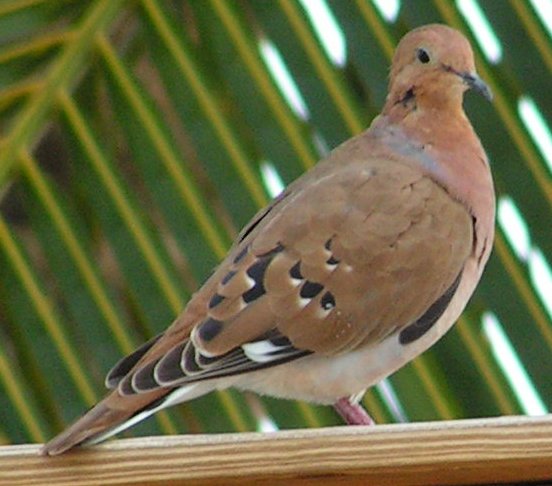- Zenaida Dove
Taxobox
name = Zenaida Dove

status = LC | status_system = IUCN3.1
regnum =Animal ia
phylum = Chordata
classis = Aves
ordo =Columbiformes
familia = Columbidae
genus = "Zenaida"
species = "Z. aurita"
binomial = "Zenaida aurita"
binomial_authority = (Temminck ,1810 )The Zenaida Dove ("Zenaida aurita") is a member of the
bird family Columbidae, which includesdove s and pigeons. It is thenational bird ofAnguilla , where it is commonly (but erroneously) referred to as aTurtle Dove . The Zenaida Dove breeds throughout theWest Indies and the tip of theYucatán Peninsula . It was reported by Audubon to breed in the Florida Keys, but there are only three verifiable records from Florida. It lays two white eggs on a flimsy platform built on a tree or shrub. It also nests in rock crevices and on grassy vegetation if no predators are present. It has been recorded of some birds having up to 4 broods per year. Eggs take approximately two weeks to hatch, and the young chicks typically fledge after only two weeks in the nest. Parents feed the young pigeon's milk, a nutrient rich substance regurgitated from its crop.The bird is resident and abundant over much of its range. Zenaida Doves are commonly hunted as a game bird. The Zenaida Dove is approximately 28–30 cm in length. It looks very similar to the
Mourning Dove , but is smaller in size, has a shorter, more rounded tail, and is a bit more darkly colored. It is also distinguished from the Mourning Dove by showing white on the trailing edge of its wings in while in flight. The Mourning Dove does not have the white trailing edge.This bird is found in a range of open and semi-open habitats. Its mournful "cooOOoo-coo-coo-coo" call is similar to the call of a Mourning Dove, but faster in pace.
These birds forage on the ground, mainly eating grains and
seed s, sometimes also oninsect s. Zenaida Doves frequently feed close to water. They often swallow finegravel to assist withdigestion , and will also ingest salt from mineral rich soils or livestock salt licks. It is thought the salt aids in egg formation and/or production of pigeon milk.References
* Database entry includes justification for why this species is of least concern
* "National Geographic" "Field Guide to the Birds of North" "America" ISBN 0-7922-6877-6
*"Handbook of the Birds of the World Vol 4", Josep del Hoyo editor, ISBN 84-87334-22-9
Wikimedia Foundation. 2010.
